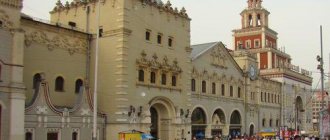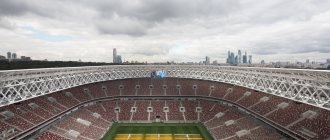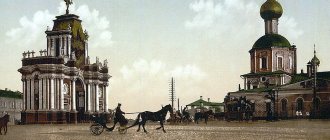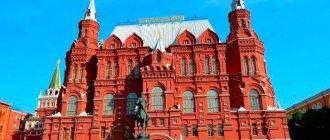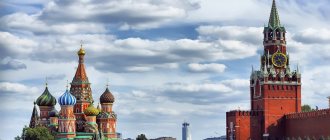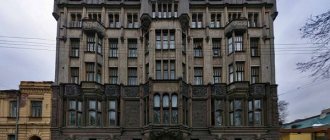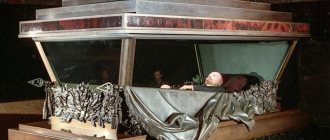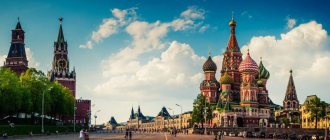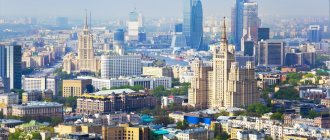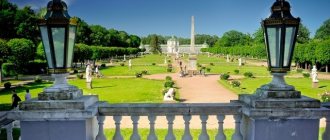Moscow Planetarium
The building of the Moscow Planetarium.
1939-41 Author ─ Alexander Ustinov. Photo: Ninel Ustinova’s archive We recommend starting your walk through the “cosmic” places of the capital from the Moscow Planetarium. In 1929, Vladimir Mayakovsky, on the occasion of its opening, wrote the poem “Proletarian, proletarian, come to the planetarium” (the planetarium is located in the Presnensky district). By the end of the 30s of the last century, star houses were only in Europe, with 10 out of 12 located in Germany, and two more in Austria and Italy. Today the Moscow Planetarium is one of the largest in the world and the oldest planetarium in Russia. The diameter of its dome is 25 meters and its area is 1000 square meters.
Urania Museum in the Moscow Planetarium. Photo: mos.ru
Great Star Hall of the Planetarium. Photo: mos.ru
Urania Museum. Photo: mos.ru
In addition to the many educational and educational projects presented here, the planetarium provides visitors with exclusive services. For example, lovers can organize a real date under the stars: a romantic rendezvous takes place after the last guest of the starry house leaves the building.
St. Sadovaya-Kudrinskaya, 5, building 1
View on map
+7
planetarium-moscow.ru
“Conquerors of Space”, Alley of Cosmonauts, Museum of Cosmonautics
Monument to the Conquerors of Space. Photo: shutterstock
Space Museum. Photo: shutterstock
Alley of Cosmonauts. Photo: shutterstock
The next point on the space map of Moscow can safely be called the alpha and omega of the history of Russian cosmonautics. On the territory of the Ostankino district there is the Museum of Cosmonautics, the monument to the Conquerors of Space and the Alley of Cosmonauts. So, by going to VDNKh, you can kill not two, but three birds with one stone - and not ordinary ones, but cosmic ones! The first of this trio was the unveiling of the monument to the “Conquerors of Space”. According to the original plan, the site for the installation of the monument was to be Vorobyovy Gory not far from the main building of Moscow State University. But it soon became clear that the future monument would not be able to fit organically into the already established natural architectural structure, so it was decided to move it to a vacant lot next to the main entrance of VDNKh. The obelisk was installed there on November 4, 1964.
One of the ideological inspirers of the construction of the “Conquerors of Space” was Sergei Korolev, the father of Russian manned cosmonautics. It was he who proposed covering the monument with titanium plates polished to a shine. Also, on his initiative, the design and technical specifications included the Museum of Cosmonautics, which was to be located in the future in the stylobate of the monument. Today, the obelisk is considered the second tallest monument in Russia (107 meters), second only to the Victory Monument on Poklonnaya Hill (141.8 meters).
Earth's first cosmonaut Yuri Gagarin and rocket and space technology designer Sergei Korolev in Yevpatoria. 1961 Source: TASS
3 years after the completion of the construction of the monument to the Conquerors of Space, the Alley of Cosmonauts appeared at VDNKh. It was opened on October 4, 1967 in honor of the 10th anniversary of the launch of the first artificial Earth satellite. By 2021, 14 monuments to outstanding figures in astronautics will be installed on the Alley of Cosmonauts.
Finally, on the occasion of the 20th anniversary of the first man’s flight into space, the Museum of Cosmonautics was opened in the stylobate of the monument to the “Conquerors of Space”. Its exposition is divided into 8 exhibition halls, and the collection includes over 96 thousand items. Among the most significant exhibits is the SK-1 spacesuit of the Vostok spacecraft cosmonaut. It was in such a spacesuit that Yuri Gagarin made the first flight into space in the history of mankind on April 12, 1961.
April 12, 1961. First cosmonaut Yuri Gagarin on a bus on his way to the launch pad. Source: Photo Chronicle
Photo: Moscow Seasons press service
Etc. Mira, 111
View on map
+7 (ext. 1016, 1006)
kosmo-museum.ru
Space Museum
At the base of the monument to the Conquerors of Space is the Museum of Cosmonautics. The original design for the monument included the construction of a museum at its base. However, the museum was not completed until 1981.
We moved to Antalya. We tell you everything in detail in our group. in contact with: https://vk.com/antalya2. Also watch our videos at YouTube:
On April 12, 2009, Cosmonautics Day, the museum was reopened after rehabilitation, which lasted 3 years. Currently, the museum no longer focuses exclusively on the achievements of the Soviet space program, but after the museum was rehabilitated, sections were added on the space programs of the United States, Europe, China and the International Space Station.
The museum offers original interactive exhibits, with training systems used by astronauts, and is one of the museums with the biggest tourist attraction in the city.
- Address : ave. Mira, 111, Moscow. Metro: VDNKh, Exhibition Center, Sergei Eisenstein Street.
- Price: Entrance to the museum costs 250 rubles. They are bought at the same museum ticket office (usually there are not many people in line). You can visit the museum in a couple of hours.
- Excursion: The museum also conducts excursions for 3,000 rubles for a minimum group of 10 people. You must reserve it in advance by calling the museum (+7 495 683-79-14). However, there are other companies that provide tours to this museum and other space age related sites.
Pavilion "Space" at VDNKh
Pavilion "Space". Zone "KB-2. Design department". Photo: Moscow Seasons press service
Model of the automatic orbital station "Almaz". Photo: Moscow Seasons press service
The last module of the Mir orbital station model. Photo: Moscow Seasons press service
In the spring of 2021, a large-scale reconstruction of the Space Pavilion (No. 34) was completed at VDNKh, where the largest museum complex in Russia and the world dedicated to the exploration of “star space” - “Cosmonautics and Aviation” - opened. The Moscow Government, the VDNKh administration, the leadership of Roscosmos and aviation and space enterprises worked together on the project. The updated pavilion displays a model of the first artificial Earth satellite Sputnik-1, a full-size model of the Mir station and the Yuri Gagarin capsule - the descent module of the Vostok-1 spacecraft.
When reconstructing the pavilion, restorers paid special attention to preserving its historical appearance. The remaining breccias were uncovered, the sculptural groups on the roof of the building were restored, and the façade was again whitened to a pleasant, soft cream color. A new chandelier with a diameter of 4.2 meters in the shape of a star was installed under the dome - a complete copy of the one installed on the Trinity Tower of the Kremlin (the real Kremlin star was used in the pavilion as a chandelier in 1954-1974).
The main entrance of the Space pavilion (No. 34) at VDNKh. Photo: Moscow Seasons press service
The new museum is unique not only in its scale, but also in rare examples of equipment and original documents that have never been exhibited in museums before ─ these are 120 exhibits of military-industrial complex enterprises, 2 thousand archival documents, photographs and video materials, as well as more than 50 exhibits specially made for museum.
Etc. Mira, 119, building 32
View on map
+7
cosmos.vdnh.ru
Monuments around the world
On May 9, 2005, a monument to Charles de Gaulle as a general was inaugurated in Moscow, although at the same time he was also the President of France (General Charles De Gaulle Le President de la Republique Francaise). The opening ceremony was attended by Russian President Vladimir Putin and French President Jacques Chirac.
Monument to Charles de Gaulle in Moscow
The date of the ceremony was also not chosen by chance, because... Charles de Gaulle was an ally of Russia during the Second World War, although he also fought in the First World War. He even sat in the same cell with Tukhachevsky, who also later became a marshal (they were captured, but constantly escaped and were caught, so they met in a camp for “incorrigible” officers). Subsequently, Charles de Gaulle became not only the leader of France, but also a symbol of the French resistance.
The monument was made by sculptor Zurab Tsereteli together with architect A.V. Kuzmin. The monument to Charles de Gaulle was presented by Zurab Tsereteli as a gift to the city of Moscow, although it is surprising that two presidents of different countries even came to receive the gift from the sculptor. The monument to Charles de Gaulle is actually a sculpture of the general on a very high pedestal. The height of the sculpture is 8 meters and is made entirely of bronze, and the high pedestal is made of granite and its height is 10 meters.
The monument to Charles de Gaulle in Moscow is located at 150 Prospekt Mira street, although this is the well-known Cosmos Hotel, so it will be easy to find, especially since it stands out from all the other houses, and the nearest metro station is VDNKh.
French veterans were invited to the opening ceremony of the monument to Charles de Gaulle, although there is no mention of Russian veterans, but I mean that a certain number were also invited.
For reference, the general's full name is Charles Andr? Joseph Marie de Gaulle and in addition to his outstanding role in the formation of France as a state, he also published several books “For a Professional Army”, “At the Edge of the Sword”, “France” and her army." But these are all more military books, not fiction.
Sculptor Zurab Tsereteli clarified that he was able to recreate the image of General Charles de Gaulle due to the fact that he saw him during his lifetime. That, despite all his years, the general has not lost his military bearing. And that the long nose, for which the future general was teased at the military school, now personifies him exclusively as a charismatic person.
The monuments of Moscow are so numerous that only the state register knows about them, but not the people for whom they were installed.
Monument to Charles de Gaulle in Moscow
House-Museum of Sergei Korolev
A little further from the monument to the pioneers of outer space there is the Korolev Memorial House-Museum, where the designer lived until his death in 1966. The academician received the site in Ostankino by decision of the Council of Ministers of the USSR for the successful launch of the world's first artificial Earth satellite. The 2-story mansion, a typical example of Soviet functionalism, was built in 1959. As Korolev’s wife recalled, Sergei Pavlovich almost every evening, leaving the house for an evening walk, visited the construction site of the future monument to the Conquerors of Space.
The Korolev House-Museum is unique in many ways - the building has never been rebuilt; only the basement rooms, expanded to store exhibits, have undergone minor changes. The rooms contain the same furniture that was used during Korolev’s life, and there are about 19 thousand storage units on display and in closed collections. These are the designer’s personal belongings, documents, letters, photographs, household items, works of fine art, scientific, technical and art libraries.
Memorial house-museum of academician Sergei Korolev. Photo: Lori's photo bank
Photo: TASS
St. 1st Ostankinskaya, 28
View on map
+7
kosmo-museum.ru/mdmk
